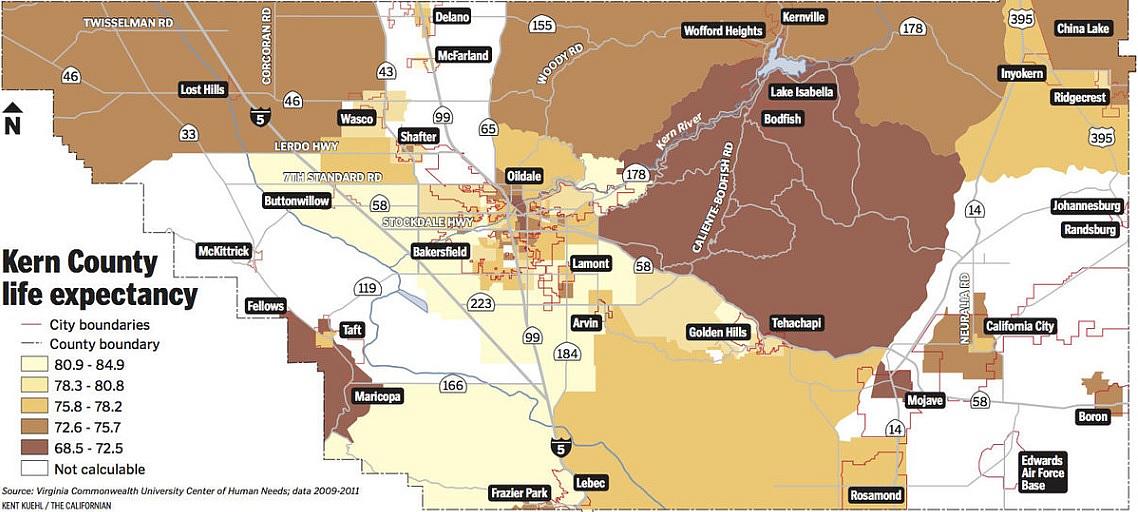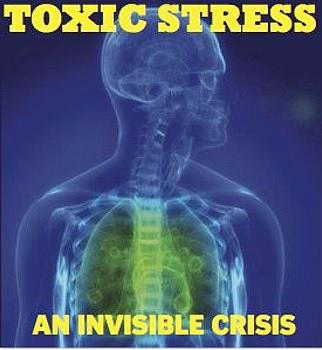'An invisible crisis': Toxic stress is helping to shorten life spans in many Kern County communities
The Californian's Harold Pierce wrote this story while participating in the USC Center for Health Journalism's California Fellowship.
Related: A year after the Erskine Fire, kids are still grappling with trauma

People who live in Oildale, Kern River Valley and Taft — three impoverished, majority-white communities — have the highest premature death rates across Kern County, dying four to 17 years sooner than those in other parts of Bakersfield.
Residents in those three communities have an average life expectancy of between 68 and 72 years old — roughly eight to 10 years less than the national average, according to data analyzed by the Virginia Commonwealth University’s Center for Human Needs.
It’s on par with life expectancies in less-developed countries like Iraq, Uzbekistan and Kazakhstan.
The culprit, health professionals say?
Drugs and poverty. But it may run deeper than that.
Many in Lake Isabella, and the surrounding communities that make up the Kern River Valley, live in trailers or shotgun houses and survive off disability and Social Security checks. Fewer than 10 percent on average have earned college degrees. Annual median incomes hover around $18,000 and dip as low as $8,000 for some households. It’s riddled with broken homes.
Mark Gordon, a chief nursing officer at the Kern Valley Hospital, stated it more succinctly: “There’s hopelessness.”
‘Deaths of Despair'
The premature death rates point to a disturbing trend cited by researchers, policy analysts and doctors: enduring a childhood of traumatic struggles like food insecurity, parental divorce and abuse creates an environment so toxic that it can have physiological impacts, wrecking the health of those it touches by leaving them at higher risk for heart disease, stroke and cardiovascular issues.
It sets others on a course of alcoholism and drug abuse — things that lead to what one researcher has called "deaths of despair."
Its impacts can begin when babies are in the womb, alter children neurologically and even change the structure of DNA, transforming the shape of family trees for generations.
It’s called toxic stress.
“It’s largely been an invisible crisis,” Dr. Anthony Iton, senior vice president for healthy communities at The California Endowment, a private statewide health foundation, told the state Senate Health Committee during a hearing this year in Bakersfield.
And it’s not a phenomenon exclusive to Kern County, although the demographics of the region — poor, white, rural and marked with economic uncertainty — are typical of those afflicted areas.
Toxic stress happens to “people who feel they’ve lost a shot at the American dream,” Iton said.
“Toxic stress is a combination of nature and nurture. It’s a combination between our DNA and our predisposed biological susceptibility and our experiences,” said Dr. Nadine Burke Harris, a toxic stress expert who founded The Center for Youth Wellness in the Bay Area.

Think of it like this: When in a high-stress situation, the body responds by going into a “fight or flight” mode, flooding the bloodstream with stress hormones like adrenaline and cortisol. That’s a healthy response that helps the body react to a threat.
But when a child endures excessive trauma, the body loses its ability to regulate stress response, and it remains in a constant “fight or flight” mode that it’s unable to turn off.
Those excessive traumas, also known as adverse childhood experiences, or ACEs, could be triggered by being sexually, emotionally or physically abused as a child, living with someone who had an alcohol or drug addiction, having a family member incarcerated, or being generally neglected, among other things, experts say. (Could you have toxic stress? Take the ACEs exam online and in print.)
So when a child lives in a home marked with domestic violence, for example, it’s a constant stress response, even if he or she doesn't experience violence daily. Just the threat triggers the body’s response, Burke Harris said.
It could be as simple as a key in the door or dad reaching for a beer — anything that could indicate violence could be happening soon, Burke Harris said.
Those experiences lead to a host of health issues. Obesity, asthma, diabetes and cardiovascular disease — all are exacerbated and sometimes caused by toxic stress, experts say.
“When the fight-or-flight response gets activated, the stress response also activates the immune response. As the immune system is more activated, you see increased inflammation. That’s why you see things like asthma and a decreased ability to fight off illnesses,” Burke Harris said. “High doses of adversity increase the risk for autoimmune disease.”
The impacts are devastating locally.
Kern Leads State In New Mothers With ACEs
New mothers in Kern County lead the state when it comes to enduring adverse childhood experiences.
About 11.6 percent of Kern County mothers reported experiencing four or more hardships during their childhoods, roughly 4 percentage points higher than the state average. An additional 20 percent reported enduring two to three hardships, according to a California Department of Public Health study of more than 14,000 mothers between 2011 and 2012.
Someone with four or more hardships, or ACEs, is 12 times more likely to die by suicide, 10 times more likely to use injection drugs and seven times more likely to become an alcoholic, according to a 2014 report published by The Center for Youth Wellness.
Kern River Valley residents suffer from astronomical rates of drug abuse leading to death. Roughly 603 per 100,000 died of a drug-related ailment between 2012 and 2016, according to death data analyzed by The Californian.
The national death rate for drug overdoses hovers around 16 per 100,000.
In Oildale, 363 per 100,000 died of causes related to drugs between 2012 and 2016, and 115 per 100,000 died from alcohol-related causes. Taft residents didn’t fare much better. About 159 per 100,000 died from causes related to drugs there, and 91 per 100,000 of alcohol-related causes.
Kern County Public Health officials acknowledged the health disparities in a statement to The Californian and said that a number of factors can contribute to Kern's poor health outcomes including poverty, geography, access to health care and lifestyle choices.
“We remain dedicated to reducing health disparities through education, policy change and improvements to the built environment all around the county. The health of our families and neighbors is a cornerstone of a thriving community and we each need to join the fight to improving our health,” Public Health spokeswoman Michelle Corson said.
To be sure, toxic stress is not the sole determining factor in drug and alcohol abuse. Some are genetically predisposed to addiction while others turn to drugs for a menagerie of other reasons. However, the emerging body of research on toxic stress points to drug abuse as a symptom of traumatic childhoods.
And it raises this question: How many kids escape the demons with which they watch their family members struggle?
Anecdotally, it doesn’t seem to happen often enough. Just about everyone in the Kern River Valley has either lived through a cycle of generational poverty and substance abuse, or knows somebody who has.
John Meyers, principal at Kern Valley High School, said the mother of one student this year came on hard times financially. She died by suicide. Then her daughter started showing signs she might do the same, he said.
“The little girl whose mom just killed herself, we had to take her to Mary K. Shell (Mental Health Facility) twice this year for being a danger to herself or others,” Meyers said. “She was out of control, saying she wanted to die.”

Drugs, he said, played a factor.
“You cannot overlook that most of, if not many, of those deaths are overdoses,” Heather Berry, a licensed clinical social worker in Wofford Heights, said when presented the premature death data. “It’s death by opiates.”
For those living in the Kern River Valley, it’s sometimes not just home lives that are toxic, but the entire region. There’s no rehabilitation center in the valley, no women’s center to seek refuge from domestic violence and no homeless shelter.
If somebody on the wrong path manages to get clean, he or she often ends up back in the valley — and that’s not ideal given the accessibility to drugs, said Terry Holbrook, who runs an adult substance abuse program at College Community Services in Lake Isabella.
“We try to get them from coming back, but that’s the hardest struggle,” Holbrook said. “This community drags them back like a magnet.”
Changing The Odds
The antidote to all this suffering, experts say, is simple.
Changing the odds just takes a nurturing relationship.
“If we’re healthy and well-regulated, it’s really the antidote,” Burke Harris said. “In rural areas like the Kern River Valley, oftentimes families are more isolated and kids have less access to that soccer coach, or religious leader, or the kind neighbor who can also be a parental figure, a mentor or a resource for these kids.”
Rural communities like the Kern River Valley, Oildale and Taft also have less access to programs like Boys & Girls Clubs of America or Big Brothers Big Sisters of America, Burke Harris said.
“All of these go a long way to providing safe, stable nurturing relationships that we know are the antidote for toxic stress,” Burke Harris said.
She points to a groundbreaking study performed at McGill University in 2003 when researchers found rat pups that were groomed by nurturing mothers fared better than those that weren’t.
Here’s how the study worked: Researchers took two sets of rats and removed them from their mothers, creating a stressful situation. Then they let one pup be licked and groomed by a mother, while the other wasn’t.
They found that the nurturing stimulated a chemical change in the brain’s glucocortoid receptor, which regulates how much stress hormone is released by the rats’ adrenal glands. The rat that was groomed less produced more stress hormones into adulthood.
Researchers discovered that when those rats gave birth, the one that wasn’t licked or groomed produced less nurturing offspring. The way they were raised actually changed the structure of their DNA.
But then they cross-fostered the pups and put them in the care of nurturing rat mothers. The result? They became more nurturing, and produced less cortisol.
“That changed their epigenetic markers,” Burke Harris said. “Through the way we raise our children, we can actually change the wiring of their stress response with nurturing caregiving.”
The point of the study, Burke Harris said, is that even though those living with toxic stress face incredible odds, there’s still hope.
[This story was originally published by The Bakersfield Californian.]

